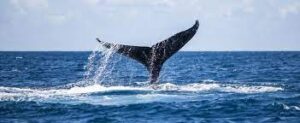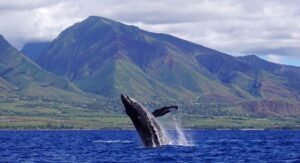Humpback whales, like many other marine mammals, are known for their remarkable migrations. Every year, humpback whales migrate from their summer feeding grounds in the cold waters of Alaska to their winter breeding and calving grounds in the warmer waters of Maui, Hawaii. This annual migration covers a distance of approximately 3,000 miles each way, making it one of the longest migrations of any mammal.

The reason why humpback whales spend the winter in Maui is primarily related to their reproductive cycle. The waters around Maui and other parts of Hawaii are warm and calm, providing a perfect environment for mating, giving birth, and caring for their young. The breeding season typically starts in late November and lasts until March or April, with peak activity occurring in January and February. During this time, male humpback whales compete for the attention of females by engaging in elaborate courtship displays that include breaching, tail slapping, and singing.
Female humpback whales give birth to their calves in these warmer waters, where they are protected from predators and have access to plentiful food sources. The newborn calves are nursed by their mothers for several months until they are strong enough to make the journey back to their summer feeding grounds in Alaska. The warm waters around Maui also offer a chance for the calves to learn important social and survival skills from their mothers and other members of the pod.

In addition to reproductive reasons, there are other factors that may contribute to the humpback whales’ choice of wintering grounds. The waters around Hawaii are relatively free of ice and have abundant food sources, such as krill and small fish, which are essential for the whales’ survival. The warm waters may also help to conserve the whales’ energy by reducing the need for them to expend energy to stay warm.
In conclusion, humpback whales spend the winter in Maui primarily for reproductive reasons, as the warm and calm waters provide a perfect environment for mating, giving birth, and caring for their young. However, other factors such as food availability and energy conservation may also contribute to their choice of wintering grounds. The annual migration of humpback whales is a remarkable natural phenomenon and a testament to the resilience and adaptability of these magnificent creatures.

https://www.ultimatewhalewatch.com/
 TIP: This week (Mid March) one our our rental car customers shared the most amazing video with everyone in our shuttle van on the way back to the airport. There were 9 male whales competing for a female and they were slapping and jumping all around the raft, sometimes in tandem. The tour boat driver from Ultimate Whale Watch & Snorkel said that was the BEST whale show of the whole season!
TIP: This week (Mid March) one our our rental car customers shared the most amazing video with everyone in our shuttle van on the way back to the airport. There were 9 male whales competing for a female and they were slapping and jumping all around the raft, sometimes in tandem. The tour boat driver from Ultimate Whale Watch & Snorkel said that was the BEST whale show of the whole season!



